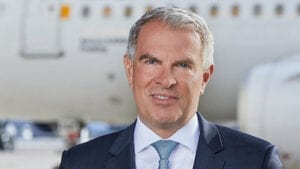
Lufthansa CEO Carsten Spohr says the German airline is losing two million euros every two hours due to COVID-19’s impact on passenger air travel. (Lufthansa)
Lufthansa CEO Carsten Spohr called for more competition between air navigation service providers (ANSPs) in Europe to encourage efficiency improvements within the region’s air traffic system during a Jan. 21 appearance on Eurocontrol’s “Aviation Hardtalks” series.
Spohr is the latest major European airline executive to discuss the status of the project, following Ryanair CEO Michael O’Leary’s criticism last month of the inability of deployment of the Single European Sky over its 17 years to de-fragment air traffic management (ATM) of European airspace, which remains subject to nation-state airspace boundary rules. However, while Spohr was also critical, he believes a European regulatory push for clean energy initiatives across most major industrial markets will give a renewed vigor to the deployment of the Single European Sky.
“There’s no competition among the ANSPs. The typical mechanisms of free markets are just not at play and that’s also the reason why with all the efficiency out there, the Single European Sky in a market environment would have been created because it’s so much more efficient, but that hasn’t happened,” Spohr said. “Never the less, I have hope. I have been working at this topic for many years and just to do it for the money obviously it didn’t happen. But now we do it for the environment.”
In December, the European Commission presented an action plan including 82 different initiatives designed to infuse new digital and greener technologies into all areas of transportation across the European Union (EU). These initiatives are also part of the European Green Deal that calls for all scheduled travel for journeys under 500 km, including airline flights, to be carbon neutral.
There is also an EU 2035 milestone for zero-emission large aircraft to become market-ready, which Airbus has committed to with potential designs already unveiled. Several individual European regulatory bodies have also included similar measures in COVID-19 government-backed airline loan programs last year as well.
Austrian Airlines received 150 million from the Republic of Austria that included several sustainability commitments required by the Lufthansa subsidiary. Among them include a pledge by the airline to increase jet fuel efficiency annually by 1.5 percent and to reduce average CO₂ emissions per 100 passenger-kilometers of the entire Austrian Airlines fleet from 9.55 kg to 8.5 kg by 2030.
When Air France received a €7 billion state-backed loan in April of last year, the nation’s finance minister required the airline to cut its carbon emissions by half per passenger and per kilometer by 2030, based on 2005 levels of emissions. Lufthansa’s latest internal effort to become greener includes establishing a new corporate responsibility unit that is already participating in a partnership in the United Arab Emirates to produce “green hydrogen” by splitting water from renewable energies such as wind or solar power to produce hydrogen power for aircraft.
“We all know that there’s detours, delays, more CO₂ footprint than necessary by the lack of efficiency. That new currency of CO₂ doing the best for our planet for the next generation, creates new energy to create the Single European Sky which we have not seen when it was just about money and passenger convenience,” Spohr said.
Overall, SESAR DM accounts for 343 total Single European Sky deployment projects, valued at about €2.9 billion ($3.4 billion). The centerpiece of research and development for several ANSPs in Europe right now is the establishment of “Virtual Centers,” explained in a SESAR Joint Undertaking (JU) webinar last year.
SESAR JU describes the Virtual Center as a concept that involves transforming the way ATM data services, such as flight data, radar, and weather information are ultimately shared between physical individual air traffic controllers and other stakeholders across the air traffic ecosystem.
Spohr is also looking for more focus on modernization on an EU-wide basis from Eurocontrol. “The one thing that I see a lot of attention on is competitiveness among European players and that is there I’ve seen the fares coming down for many many years. But when it comes to efficiency in the system, especially compared to systems outside of Europe, I don’t hear that those voices strongly enough, I think Eurocontrol can play a role there it has to be pushing for modernization of the system,” he said.

Lufthansa’s air cargo business had a “record-breaking” 2020 compared to the passenger side of its operations, according to Spohr. (Lufthansa)
COVID-19’s impact on passenger demand has Lufthansa currently losing €1 million ($1.2 million) every two hours, according to Spohr. Lufthansa had a “record-breaking” year according to Spohr, on the air cargo side of its business, with the CEO noting that they will be operating more cargo-configured MD-11s than expected as a result of increased demand for cargo shipments.
Right now, Lufthansa is one of many European airlines operating at historic lows, as the German carrier is currently operating at 20 percent of its capacity with less than half of its in-service fleet active. Spohr expects passenger travel to remain flat and relatively unchanged in the first quarter of 2021 compared to the fourth quarter of 2020.
“I’m sure that somewhere between the second and third quarter I think the vaccination effect will come into place,” Spohr said. “Testing will become more professional, which we have been pushing for some time, hopefully, quarantine will be eventually pushed back by testing and vaccination and that will give us a sharp recovery around the summer period.”